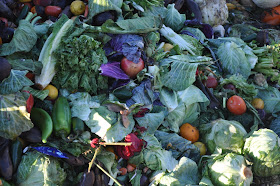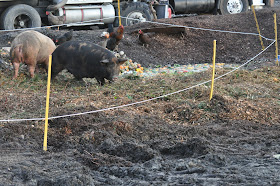A good harvest means lower prices, in general, and a poor harvest means higher prices, in general. Left to their own devices, food supplies pretty closely match demand over time, and in general, they get closer to that demand level over time, but random factors like weather, disease and pests interfere with this natural efficiency, both in good and bad ways.
It's pretty easy to understand. If you're a farmer, you produce what you can consume or sell; in today's world, most farmers sell most of their production. If you don't sell it, you have to either store it until you can sell it -- higher costs -- or just discard it. Sometimes, even after storing it for a while, you have to discard it, which is the worst possible outcome.
Farmers can and do change crops from year to year, for a variety of reasons. One of those reasons is the price being offered for a particular crop. People who feed animals, and I'm one of those people, consider the overall costs of a particular food, and make changes from time to time, sometimes on efficiency, but it all boils down to price. If I can cut my feed bill by 10% and get the same results, I'll do that as soon as I can.
A local chicken producer near me was complaining that fish meal prices had doubled because a fish meal plant in Chile had burned down in an earthquake. He buys his fishmeal from a supplier in Alaska. Why would a fire in Chile affect prices in Alaska, or Washington? Because in toady's world any producer can sell to any consumer anywhere in the world, and when the music ended, someone didn't get the fishmeal that they needed, and so everyone bid more for it -- globally.
Governments like stable food supplies. There's nothing to make your populace more angry than being hungry, and in poor countries this is a very real, and very present, risk. If you are in the government, you better make sure that you have adequate food around or you'll pay a significant poltical price for not. **
Rich made this comment on my blog:
(Rich is quoting me: )
"...prices are up for corn, and the primary reason is our continued use of food as fuel in ethanol..." It is easy to blame ethanol for all the ills in the world, but I haven't seen an explanation for why prices dropped so much last year. Was less ethanol produced last summer, leading to less demand for corn resulting in a greatly reduced price? Wheat was about $6.50/bu last spring, dropped to almost $3.50/bu at harvest last summer, and is now around $8.50 to $9.00. How did ethanol production cause that? Ethanol has linked the price of grain to the price of oil while eliminating the great surpluses that stole all the profit out of grain production in the '70's. A better explanation can be found at: http://frankwjames.blogspot.com/2011/01/recovering.html Quantitative Easing 2 (increasing the money supply by 20%) also had to have an effect on the price of corn and other grains. How can corn not increase in price if it takes 20% more dollars to purchase a bushel of corn?
*In 2010 the USDA estimates that we will consume 4.950,000,000 (4.95 billion bushels) of corn to produce ethanol. That production is directly subsidized by the government -- for every gallon of ethanol produced, there's a 45 cent subsidy, and the market for this alcohol is artificial. The demand is created by a set of federal laws mandating the addition of alcohol to motor vehicle fuel, despite the fact that it's very expensive and reduces mileage -- requiring people to use more fuel to accomplish the same work. Ethanol is really popular in local governments, because it increases gas tax revenues -- people are paying for more gallons of fuel everywhere ethanol is used.
That's 40% of the corn production of the USA, by the way. 40% of the corn produced that would normally either feed animals, be used for seed or for human consumption is consumed in this enterprise.
The blog entry referenced by Rich isn't really the point I'm making. It's written by a corn and soybean farmer, and talks about subsidies and the fact that in times when we've had crops to spare, poor people around the world couldn't afford to get it shipped to them even if we gave it to them for free. That's a different issue, a political issue, and as I've said earlier, something for governments to worry about.
My issue with ethanol production, or in a wider sense, converting any sort of food into something other than food, is that if you add even a little tiny amount of demand to our finely tuned food system that causes huge disruptions.
We're playing musical chairs, and suddenly everyone realizes that someone is going to be left standing. And that's where the rich countries outbid the poorer ones, and during that bidding, prices go crazy. That's my concern.
Do we have to worry about food supplies in the USA? Not really. We're the richest country on this planet. We spend less of our total income on food than anywhere else in the world. We could double our food costs and still be below many countries, measured as a percentage of income. No worries about hunger here. We can outbid anyone.
But I don't think that we should be using our riches to starve people, or to increase the misery index of the world. That's just plain evil.
** Bolivia is a country that would rather not have food riots or political unrest related to food supplies, so they're buying food. This is not limited to Bolivia, and is true in the USA as well. Unstable food supplies in the USA have caused us to enact a series of laws and regulations that attempt to stabilize our food supply. Some of these work, some don't.


























